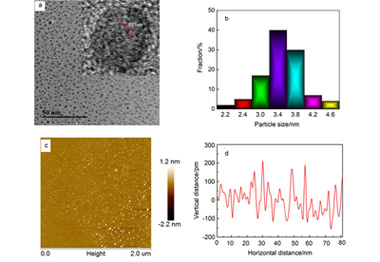| [1] Bruce, P. G.; Freunberger, S. A.; Hardwick, L. J.; Tarascon, J. M. Nature. Mater. 2012, 11, 19.
[2] Tarascon, J. M.; Armand, M. Nature 2001, 414, 359.
[3] Megahed, S.; Scrosati, B. J. Power Sources 1994, 51, 79.
[4] Kasavajjula, U.; Wang, C.; Appleby, A. J. J. Power Sources 2007, 163, 1003.
[5] Luo, F.; Zheng, J.-Y.; Chu, G.; Liu, B.-N.; Zhang, S.-L.; Li, H.; Chen, L.-Q. Acta Chim. Sinica 2015, 73, 808 (in Chinese). (罗飞, 郑杰允, 褚赓, 刘柏男, 张素林, 李泓, 陈立泉, 化学学报, 2015, 73, 808.)
[6] Ye, Y.; Zhu, J.-Y.; Yao, Y.-N.; Wang, Y.-G.; Wu, P.; Tang, Y.-W.; Zhou, Y.-M.; Lu, T.-H. Acta Chim. Sinica 2015, 73, 151 (in Chinese). (叶亚, 朱婧怡, 姚依男, 王雨果, 吴平, 唐亚文, 周益明, 陆天虹, 化学学报, 2015, 73, 151.)
[7] Wen, L.; Liu, C.-M.; Song, R.-S.; Luo, H.-Z.; Shi, Y.; Li, F.; Cheng, H.-M. Acta Chim. Sinica 2014, 72, 333 (in Chinese). (闻雷, 刘成名, 宋仁升, 罗洪泽, 石颖, 李峰, 成会明, 化学学报, 2014, 72, 333.)
[8] Boukamp, B. A.; Lesh, G. C.; Huggins, R. A. J. Electrochem. Soc. 1981, 128, 725.
[9] Obrovac, M. N.; Christensen, L. Electrochem. Solid. ST. 2004, 7, A93.
[10] Chan, C. K.; Ruffo, R.; Hong, S. S.; Huggins, R. A.; Cui, Y. J. Power Sources 2009, 189, 34.
[11] Li, H.; Huang, X. J.; Chen, L. Q.; Zhou, G. W.; Zhang, Z.; Yu, D. P.; Mo, Y. J.; Pei, N. Solid State Ionics 2000, 135, 181.
[12] Yu, Y.; Gu, L.; Zhu, C. B.; Tsukimoto, S.; Aken, P. A.; Maier, J. Adv. Mater. 2010, 22, 2247.
[13] Howe, J. Y.; Burton, D. J.; Qi, Y.; Meyer, H. M.; Nazri, M.; Nazri, G. A.; Palmer, A. C.; Lake, P. D. J. Power Sources 2013, 221, 455.
[14] Sandu, I.; Moreau, P.; Guyomard, D.; Brousse, T.; Roue, L. Solid. State Ionics 2007, 178, 1297.
[15] Ge, M.; Rong, J. P.; Fang, X.; Zhou, C. W. Nano Lett. 2012, 12, 2318.
[16] Abel, P. R.; Lin, Y. M.; Celio, H.; Heller, A.; Mullins, C. B. ACS Nano 2012, 6, 2506.
[17] Chen, D. Y.; Mei, X.; Ji, G.; Lu, M. H.; Xie, J. P.; Lu, J. M.; Lee, J. Y. Angew. Chem. Int. Ed. 2012, 51, 2409.
[18] Li, H.; Huang, X. J.; Chen, L. Q.; Wu, Z. G.; Liang, Y. Electrochem. Solid-State Lett. 1999, 11, 547.
[19] Kim, T. H.; Park, J. S.; Chang, S. K.; Choi, S.; Ryu, J. H.; Song, H. K. Adv. Eng. Mater. 2012, 2, 860.
[20] Wang, M. S.; Song, W. L.; Fan, L. Z. ChemElectroChem. 2015, 2, 1699.
[21] Wang, B.-F.; Yang, J.; Xie, J.-Y.; Wang, K.; Weng, Z.-S.; Yu, X.-G. Acta Chim. Sinica 2003, 61, 1572 (in Chinese). (王保峰, 杨军, 解晶莹, 王可, 文钟晟, 喻献国, 化学学报, 2003, 61, 1572.)
[22] Wang, B.; Li, X. L.; Zhang, X. F.; Luo, B.; Jin, M. H.; Liang, M. H.; Dayeh, S. A.; Picraux, S. T.; Zhi, L. J. ACS Nano 2013, 7, 1437.
[23] Yan, M. Y.; Wang, F. C.; Han, C. H.; Ma, X. Y.; Xu, X.; An, Q. Y.; Xu, L.; Niu, C. J.; Zhao, Y. L.; Tian, X. C.; Hu, P.; Wu, H. G.; Mai, L. Q. J. Am. Chem. Soc. 2013, 135, 18176.
[24] Luo, Z. P.; Xiao, Q. Z.; Lei, G. T.; Li, Z. H.; Tang, C. J. Carbon 2016, 98, 373.
[25] Zhao, K. N.; Zhang, L.; Xia, R.; Dong, Y. F.; Xu, W. W.; Niu, C. J.; He, L.; Yan, M. Y.; Qu, L. B.; Mai, L. Q. Small 2015, 12, 588.
[26] Chou, S. L.; Wang, J. Z.; Choucair, M.; Liu, H. K.; Stride, J. A.; Dou, S. X. Electrochem. Commun. 2010, 12, 303.
[27] Wang, J. Z.; Zhong, C.; Chou, S. L.; Liu, H. K. Electrochem. Commun. 2010, 12, 1467.
[28] Bacon, M.; Bradley, S. J.; Nann, T. Part. Part. Syst. Char. 2014, 31, 415.
[29] Huynh, W. U.; Dittmer, J. J.; Alivisatos, A. P. Science 2002, 295, 2425.
[30] Son, D. I.; Kwon, B. W.; Park, D. H.; Seo, W. S.; Yi, Y.; Angadi, B.; Lee, C. L.; Choi, W. K. Nat. Nanotechnol. 2012, 7, 465.
[31] Lin, J.; Zhang, C. G.; Yan, Z.; Zhu, Y.; Peng, Z. W.; Hauge, R. H.; Natelson, D.; Tour, J. M. Nano. Lett. 2012, 13, 72.
[32] Gao, P.; Ding, K.; Wang, Y.; Ruan, K. Q.; Diao, S. L.; Zhang, Q.; Sun, B. Q.; Jie, J. S. J. Phys. Chem. C 2014, 118, 5164.
[33] Li, R. Y.; Jiang, Y. Y.; Zhou, X. Y.; Li, Z. J.; Gu, Z. G.; Wang, G. L. Electrochim. Acta 2015, 178, 303.
[34] Tetsuka, H.; Asahi, R.; Nagoya, A.; Okamoto, K.; Tajima, I.; Ohta, R.; Okamoto, A. Adv. Mater. 2012, 24, 5333.
[35] Peng, J.; Gao, W.; Gupta, B. K.; Liu, Z.; Aburto, R. R.; Ge, L. H.; Song, L.; Alemany, L. B.; Zhan, X. B.; Gao, G. H.; Vithayathil, S. A.; Kaipparettu, B. A.; Marti, A. A.; Hayashi, T.; Zhu, J. J.; Ajayan, P. M. Nano Lett. 2012, 12, 844.
[36] Jeong, J. H.; Kim, K. H.; Jung, D. W.; Kim, K.; Lee, S. M.; Oh, E. S. J. Power Sources 2015, 300, 182. |
